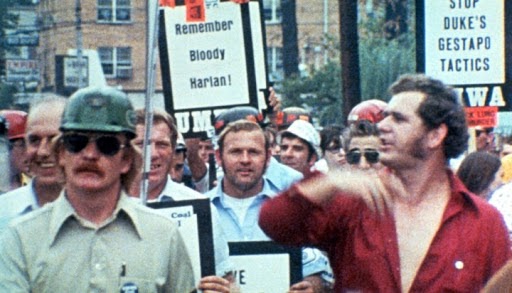
In any estimation, Barbara Kopple’s Oscar-winning Harlan County, USA is one of the most influential documentaries in American history. A gripping chronicle of a 13-month coal miners’ strike in eastern Kentucky, the film was one of the first documentaries to reach a mainstream American audience. It is a must-have for any socially conscious cinephile’s collection.
However, almost 50 years on, Harlan County, USA remains especially important to people from Appalachia due to its examination of an oft-forgotten era of the region’s labor history.
Detailing events half a century after the more-discussed Mine Wars, Harlan County shows what came after the events of John Sayles’ Matewan, exploring the robust system of labor organizing that miners and their families painstakingly built over much of the 20th century. Perhaps more importantly, in documenting that system just a few years before the Reagan era’s anti-unionism started its unraveling, the film serves as an unwitting time capsule of an Appalachia much more radical than the one many of us grew up with.
Set in the eastern Kentucky county, at its heart Harlan County follows the 1973-1974 Brookside Mine strike, launched after the mine’s ownership refused to recognize the local union’s contract.
Filmed in the cinema verite style without narration, the film follows several different narrative strands as the miners and their families—most notably their autonomously organized wives—campaign in the face of company violence, abysmal living conditions, and divisions within their own ranks. Interspersed throughout are clips explaining the strike’s place within the tumultuous national union politics of the 1970s.
Cinematically, Harlan County is an intimately shot portrait of life in the coalfields. Kopple lived in Harlan for over a year while filming the documentary, shooting hundreds of hours of meetings, demonstrations, and personal conversations that give the film a grounded perspective. Although Kopple shows the poverty of a coal company town, very little of the film feels exploitative given her centering of local voices in their fight for a better life.
Uniquely, Harlan County captures the violence faced by labor organizers, with one of its most famous scenes being of company gun thugs attempting to attack the film crew themselves in the dead of night.

Another notable feature of Harlan County is its soundtrack. Featuring the likes of West Virginia legend Hazel Dickens and Sarah Gunning, the film bristles with authentic miner and regional folk songs that give it a distinctive character.
A recurring motif throughout the film is the union classic “Which Side Are You On?” originally composed by Harlan County native Florence Reece during the violent clashes of “Bloody Harlan” in the 1930s. In a standout moment, the film features the then-elderly Reece reflecting on the trajectory of the labor movement since “Bloody Harlan” to a crowded union meeting—casually quoting Marx while doing so—giving viewers a glimpse into the area’s genuinely radical history.
It is this sense of radicalism, and its dissonance with how Appalachia is presented today, that stands out watching Harlan County five decades later. Most of the film’s subjects are second- or third-generation coal miners, not the liberal, college-educated types one would expect to quote Marxist theory. And yet, peppered throughout are lines hinting at a dominant worldview very different from the Trumpism that has dominated some depictions of the region.
Far from being corporate-sponsored “Friends of Coal,” miners in Harlan County casually reference the irreconcilable interests of management and workers. They display a deep sense of history and their place in it, presenting their strike as merely the latest battle in a long, ongoing war by workers for a better life. And, perhaps most strikingly given current economic prospects in the region, they seem genuinely confident in their ability to win that war in an ever-forward march of progress.
This sense of confidence and agency is also shared by the miner’s wives, one of the film’s major focuses. If the film could be said to have a main character, it would be Lois Scott, a leader of the miner’s women’s auxiliary who is a driving force behind the strike. In a memorable scene, she pulls a revolver out of her bra while advocating the miners’ arm themselves for protection.
Harlan County shows women at the forefront of organizing efforts, literally putting their bodies in between the striking miners and state police while also dealing with the added burden of running a household.

Watching these self-confident men and women in the light of current circumstances adds a tragic element to Harlan County, USA.
Although the film’s subjects don’t know it, the structure of the world economy had already started to shift by the time of the documentary’s filming, and the Reagan Administration would begin a decades-long attack on unions just a few years later, undermining the basis for the solidarity displayed in the film. While the recent Blackjewel standoff in Harlan County showed the area’s radical spirit lives on, the breakdown of the union system in Appalachia goes a long way in explaining how a region once known for its Marx-quoting miners eventually went for a different sort of red.
So, whether you’re wanting to reclaim Appalachia’s radicalism or just want a solid labor flick, Harlan County, USA does not disappoint. Check it out now on the Criterion Channel streaming service.
Nicholas Brumfield is a native of Parkersburg, WV currently working in Arlington, VA. He also comes from a proud family of nurses, including his sister and aunt. For more hot takes on Appalachia and Ohio politics, follow him on Twitter: @NickJBrumfield.
Subscribe to The Patch, our newsletter, to stay up-to-date with new expatalachians articles and news from around Appalachia.


